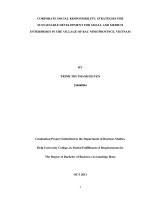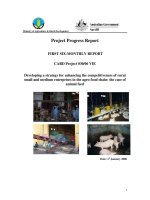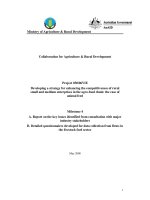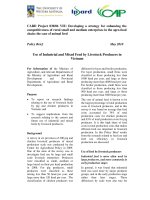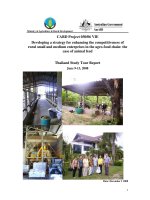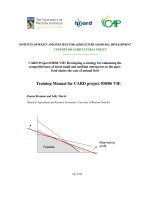Effects of supply chain integration on firm’s performance: A study on micro, small and medium enterprises in India
Bạn đang xem bản rút gọn của tài liệu. Xem và tải ngay bản đầy đủ của tài liệu tại đây (977.67 KB, 10 trang )
Uncertain Supply Chain Management 8 (2020) 231–240
Contents lists available at GrowingScience
Uncertain Supply Chain Management
homepage: www.GrowingScience.com/uscm
Effects of supply chain integration on firm’s performance: A study on micro, small and medium
enterprises in India
A. Subburaja*, V.P. Sriramb and Sangeeta Mehroliaa
a
Institute of management, CHRIST (Deemed to be University), Bangalore, India
Acharya Bangalore B-School (ABBS), Bengaluru, India
b
CHRONICLE
Article history:
Received June 5, 2019
Received in revised format June
20, 2019
Accepted July 2 2019
Available online
July 2 2019
Keywords:
Supply Chain Integration
Organizational Performance
MSMEs
Customer Integration
Supplier Integration
Internal Integration
ABSTRACT
The cooperation in the supply chain assumes an adequate job for enhancing an organisation's
performance and increasing competitive advantage. Supply Chain Integration (SCI) affects
organisational performance. This paper studies the impact of the integration of supply chain
procedures and practices on organisational performance and explores the effect of SCI on
organisational performance at Micro, Small and Medium Enterprises (MSMEs) in Madurai
District, Tamilnadu, India. A questionnaire is developed with validated measurement scales
from previous studies and empirical data are collected through a survey questionnaire from
250 randomly selected MSMEs. This research provides sound recommendations to MSMEs in
Madurai District, Tamilnadu, India, and maybe used for different industries and decision
making policies. Finally, the study will contribute to the scientific field by providing some
future studies.
© 2020 by the authors; licensee Growing Science, Canada.
1. Introduction
Globalisation was led by advancement in communication and transportation (Ataseven & Nair, 2017).
Because of globalisation, customers' requirements and needs are changing rapidly. Buyers require
appropriate goods and services at a reasonable price and in a reasonable time with high quality and the
right place. If organisations want to compete in the new market, they should correspond with the
beforehand customers' demands (Cao & Zhang, 2011; Gimenez, van der Vaart, & Pieter van Donk,
2012). To satisfy the customers' needs, organisations should enhance all their activities and strategies.
Supply Chain Management (SCM) is a framework that enhances all processes accomplished by the
organisations (Arzu Akyuz & Erman Erkan, 2010). SCM is a complicated operation that includes all
supportive movements of vendors, suppliers to after-sales services. To have the capacity to develop
and endure any organisation needs to recognise its qualities and deficiencies and to re-enforces on
conditions and conquer weaknesses (Wong et al., 2010). Actualising SCM can be a foundation of
competitive advantages (Ou et al., 2010) which prime to better performance by and overall
organisations' performance (Danese & Romano, 2011).
* Corresponding author
E-mail address: (A. Subburaj)
© 2020 by the authors; licensee Growing Science.
doi: 10.5267/j.uscm.2019.7.001
232
The cooperation in the supply chain assumes an adequate job for enhancing an organisation's
performance and increasing competitive advantage. To use the supply chain at its most extreme
performance level, organisations need to incorporate their objectives and practices together (Prajogo &
Olhager, 2012; Ralston et al., 2015). The supply chain partners need to concentrate on different
components to guarantee competitive advantage: cost negotiation to increment in profit, and financial
collaboration effort to support innovative product design (Arzu Akyuz & Erman Erkan, 2010; Prajogo
& Olhager, 2012). The SCM involves integration and synchronisation for achieving and reacting to
customer request changes (Flynn et al., 2010; Govindan et al., 2015). Studies demonstrate that Supply
Chain Integration (SCI) affects organisational performance (Prajogo & Olhager, 2012; Ralston et al.,
2015; Prajogo et al., 2016). Like this, it appears that its value must be reflected to the impact of the
integration of supply chain procedures and practices on organisational performance, so this research
explores the effect of SCI on organisational performance at Micro, Small and Medium Enterprises
(MSMEs) in Madurai District, Tamilnadu, India.
The MSMEs have been contributing substantially to the extension of entrepreneurial endeavours
through business improvements. The MSMEs are broadening their domain across over parts of the
economy, delivering the differing range of products and services to meet requests of worldwide markets
(Ministry of Micro, Small and Medium Enterprises, 2018). Thus, the MSMEs performance will affect
the nation's economy. Studies also reveal that MSMEs in Madurai district are confronting numerous
difficulties and obstacles which thus influenced the overall performance at these organisations (Flynn
et al., 2010; Danese & Romano, 2011; Huo, 2012). Mostly MSMEs in Madurai district worried about
accomplishing their very own goals independently and constant changing in customer needs and
requirements because of extreme competitions among the organisations. Consequently, this leads to
challenges in integrating supply chain activities and procedures, which delay supplying products and
services to customers in the appropriate place at a reasonable time and loss of competitive advantage
(Huo, 2012).
This study aims to examine the effect of SCI on organisational performance in Madurai District,
Tamilnadu, India. This research will also give sound recommendations to MSMEs in Madurai District,
Tamilnadu, India, and for other industries. Finally, this study will contribute to the scientific field.
These days, the focus of SCI and organisational performance is to get increasingly more significance
because of its effect on an organisation's existence, steadiness, and progress. Thus, reviewing the impact
of SCI on a firm’s performance is an essential subject for organisations, and for academicians. This
study may be considered as an initiative that investigates the effect of SCI on organisational
performance at MSMEs. Subsequently, enough knowledge about the SCI in organisational
performance will enhance MSMEs performance. Outcomes of this research are critical for MSMEs, as
well as for different industries, decision makers and the academicians.
2. Literature Review
Different literature characterised SCI and supply chain performance in various ways, and every
definition was custom fitted as indicated by the idea of the study, business, and research objective. SCI
is about cooperation, collaboration and coordination among various players of the supply chain, which
upgrades an organisation's performance. The accompanying segment will handle the ideas of SCI and
supply chain performance, and the relationship between them.
2.1. Supply Chain Integration
In this study, SCI is characterised as the procedure of collaboration inside supply chain players that
oversee inter and intra-organization activities to accomplish efficient flow of products, services and
information to provide most extreme value to the customer in the right place at a reasonable cost
(Rosenzweig et al., 2003; Bagchi et al., 2005; Zelbst et al., 2009).
A. Subburaj et al. /Uncertain Supply Chain Management 8 (2020)
233
2.2 Supply Chain Integration Elements
SCM can be grouped into three dimensions to the better comprehension of SCI (Stank et al., 2001;
Zhao et al., 2008; Fabbe-Costes & Jahre, 2008). Suppliers are contemplating about the principal sources
of information and input that are required by the organisational tasks, so they have an essential job in
the continuation of assembling products and/or services to meet customer requirements (Armistead &
Mapes, 1993; Rosenzweig et al., 2003). In recent years, manufacturing organisations tend to form a
stable relationship with their suppliers to deal with the variance in demands of the customers and
lessening the production cycle time and delivery time defined by the firm and the customers (Bagchi
et al., 2005; Zhao et al., 2011; Huo, 2012). Suppliers now are progressively associated with creating
the products to promote production and remaining neighbouring to the customer (Kim, 2009; Alam et
al., 2014). Therefore, the investigation characterised supplier integration (SI) as the procedure of
cooperation among partners and organisation that encourage the distribution of data, experience,
materials and services. Correct items that redirect the purpose of the partnership, association, and
additional applicable matters among supplier and firms assessed the SI.
Internal integration (II) is the focal point of gravity for the two suppliers and customers, and it's viewed
as the essence that keeps up the stability and consistency for all supply chain parties so that the
organisation could make neither supplier nor CI without II (Wong et al., 2011; Huo, 2012; Xu, Huo &
Sun, 2014). Building the exact supply chain procedure depends firmly on the presence of clear and
shared objectives, which initially got from the acceptance of all functional divisions of the
organisational goals (Zelbst et al., 2009; Prajogo & Olhager, 2012; Huo, 2012; Govindan et al., 2015).
Within sight of such understanding, every division is thinking about two sorts of customers (Huo, 2012;
Zhang & Huo, 2013; Zhang & Huo, 2013; Leuschner et al., 2013). The primitive customer is the
preeminent client that the organisation aims to render with the finished goods or services, and the
secondary customer is different divisions or the human resources where relying on the different
outcomes to keep accomplishing their tasks and therefore the organisation can achieving the goal
(Flynn et al., 2010; Danese & Romano, 2011; Ataseven & Nair, 2017). In this study, II is determined
as the way toward keeping up cross-functional participation and collaboration inside the organisation
that means to achieve strategic organisational goals. It was estimated by a group of indicators that
identified the purpose of a link, coordination and cooperation between various departments.
The organisation is considering the customers as of the source of life, so forth organisations give either
goods or services, and it's viewed as the natural air that is required by the organisation to develop and
having the capacity to withstand in the presence of the substantial and extreme competitions (FabbeCostes & Jahre, 2008; Leuschner et al., 2013). Customer needs and requirements are changed
continuously, so what was viewed as significant in the past possibly becomes complementary in near
future (Petersen et al., 2005; Mellat-Parast & Spillan, 2014). Accordingly, the organisations should
observe the external environments. Moreover, it should carry on proactively yet not reactively being
better over competitors in performing customer needs (Bagchi et al., 2005; Danese & Romano, 2011;
Yu et al., 2013). In the current study, CI is characterised as the way toward building and keeping up a
stable relationship and partnership with the customers. It incorporates sharing information, service,
outputs, and recommendations with customers. It was estimated by chosen items that investigate the
involvement and cooperation related concerns. The current research addresses the SCI, which
incorporates supplier, internal and CI.
2.3 Organisational Performance
A more extensive conceptualisation and progressively efficient performance measure should
incorporate indicators of operational performance, besides, those of financial performance
(Gunasekaran, Patel, & Tirtiroglu, 2001; Hervani et al., 2005). This is primarily because non-financial
measures can overcome the limitations of merely utilising financial performance measures. There are
234
numerous advantages on employing non-financial measures, including the facts that non-financial
measures are timelier than financial ones. The financial performance measures are increasingly
quantifiable, and they are predictable with organisation objectives and strategies (Chang et al., 2003;
Martínez Sánchez & Pérez Pérez, 2005). However, non-financial measures change and differ after some
time as market needs change and hence manage to be flexible (Gunasekaran, Patel, & Tirtiroglu, 2001;
Gunasekaran, 2004). While financial performance measures are bound to reflect the evaluation of a
firm by components outside of the organisation's limits, operational measures indicate about more
straightforwardly the effectiveness of the tasks inside the organisation (Gupta & Somers, 1996; Chang
et al., 2003). These classifications of performance reflect competencies in specific areas of the supply
chain, including cost, transportation speed and consistent quality, reliability, and customer satisfaction.
Organisational performance measures give a reasonable indication of the efforts of the supply chain
dimensions. Perceiving the significance of financial and non-financial performance, supply chain
organisation must incorporate both measurements.
2.4 Conceptual Model
Based on the above literature discussions, the framework of SCI and company performance was
developed. Mostly, the current conceptual model was modified and adapted from Huo (2012) study on
the impact of SCI on company performance: an organisational capability perspective.
Fig. 1. Conceptual Model
2.5 The hypothesis of the study
The above stated conceptual model below stated hypotheses was tested.
H01: SCI has a significant impact on the firm’s financial performance
H02: SCI has a significant effect on the firm’s non-financial performance
3. Methods
The target population of the study was micro, small and medium enterprises in Madurai district, Tamil
Nadu, India. Information about the MSMEs was collected from the micro, small and medium
enterprises (MSME) department of Tamil Nadu state government website. 29,485 MSME units of
Madurai District are registered with the MSME department. The targeted respondents for the
questionnaire were primarily chief executive officers, managing directors, owners of firms or senior
officers/executives in charge of supply chain practices in companies who would have adequate
A. Subburaj et al. /Uncertain Supply Chain Management 8 (2020)
235
knowledge of how their firms carry out their supply chain functions and how effective is their
performance. Since interviewer-administered questionnaires were used to collect the data and the
response rate for interviewer-administered questionnaires is 90%, 300 SMEs were randomly selected
for the research. After the data collection, 50 questionnaires were removed from the research due to
incomplete, biased and outlier issues. Only 250 completed cleaned data were used for calculation.
Empirical data was collected through a survey questionnaire.
3.1. Instrument Development
Based on literature review, the researcher has identified three variables that contribute to MSMEs
performance (SI, II & CI) 10 items and the total measured each variable were 30 items (from item 1 to
item 30 in the questionnaire). For instance, respondents were asked to indicate the importance of SCI
to the accomplishment of their supply chain performance, using a seven-point scale with endpoints
“Strongly disagree” (1) and “strongly agree” (7) adopted from Saleh (2015). In this study, four
dimensions are used to measure a firm’s performance. Respondents were asked to rate overall
performance using the following measures: sales growth, net profit, customer satisfaction, and order
lead time. Customer satisfaction was measured by multiple items, and the remaining three dimensions
were measured by a single item, adopted from Gunasekaran (2004), Gupta and Somers (1996). First,
sales growth was measured by sales growth rate. Second, net profit was measured regarding net profit
rate. Third, customer satisfaction was considered regarding the level of customer perceived value of
the product, the level of service systems to meet customer needs, and response time to a customer query.
Fourth, lead time was measured by a single indicator order lead-time. To provide the supply chain
managers with a broader view, each measure of the firm’s performance discussed above was evaluated
about the firm’s major competitors during three years. The criteria compared with the relative major
competitors for the last three years the response options, anchored on a seven-point scale with “1” being
“Very Weak” and “7” being “Very Strong” was adopted from Aissa Fantazy et al. (2009). The
questionnaire was developed with validated measurement scales from previous studies that examined
constructs in a query in the present study.
4. Results
It is necessary to test that the measurement model has a satisfactory level of validity and reliability
before testing for a significant relationship in the structural model (Fornell & Larcker, 1981).
Psychometric properties of the measurement model were evaluated with composite reliability (CR) and
convergent validity (Hair et al., 1998). All constructs exhibited CR with the minimum acceptable level
of 0.60, indicating excellent reliability. Fornell and Locker’s average variance extracted (AVE)
criterion is followed for the estimation of scales’ convergent validity. AVE value of a latent variable
should be higher than 0.50, to explain more than half of the variance of its indicators on average
(Malhotra & Dash, 2011; Hair et al., 1998). As depicted in Table 1, all the latent constructs (supply
chain integration) met this criterion.
Table 1
Validity and Reliability of the research scale
Dimensions
CR
AVE
1. Supplier integration
0.912 0.512
2. Internal integration
0.910 0.505
3. Customer integration
0.921 0.541
MSV
0.069
0.030
0.069
MaxR(H)
0.923
0.916
0.934
1
0.716
0.172*
0.264**
2
3
0.711
0.072
0.735
Note: *p<0.05; **p<0.01
Table 1 concludes that all Composite Reliability (0.7) and convergent validity approach was used and
it shows that Average Variance Extracted values (0.5) for all construct are higher than normal levels.
It supports Composite reliability and convergent validity of the constructs. Table 1 also shows that
236
Maximum shared variance (MSV) is less than AVE, Maximum reliability (MaxR (H)) is greater than
CR, AVE and the square root of AVE is greater than inter-construct correlations which support the
discriminant validity of the construct (Hu & Bentler, 1999).
Fig. 2. Impact of SCI on supply chain performance
Table 2
Standardized coefficient table
Structural Relationship
Non-Financial Performance
Financial Performance
Customer Integration
Internal Integration
Supplier Integration
Lead Time
Customer satisfaction
Sales Growth
Net profit
←
←
←
←
←
←
←
←
←
Supply Chain Integration
Non-Financial Performance
Financial Performance
Beta
0.646**
0.830**
0.658**
0.633**
0.804**
0.463**
0.553**
0.414**
0.451**
**p<0.01
Table 2 shows the structural relationship between the SCI and financial, the non-financial performance
of the MSMEs in Madurai District. Overall SCI has significantly predicted all three SCI dimensions,
among those three dimensions, SI (beta=0.804; p<0.01) is the most significant predictor than II
(beta=0.658; p<0.01) and CI (beta=0.633; p<0.01). The customer satisfaction (beta=0.553; p<0.01) is
the most significant predictor of non-financial performance and Net profit (beta=0.451; p<0.01) is the
most significant predictor of the financial performance of the MSMEs in Madurai District. Supply chain
integrations have direct effects on the supply chain’s financial performance (beta=0.830; p<0.01) and
non-financial performance (beta=0.646; p<0.01) and hence, H01 and H02 are supported.
Table 3
Model Fit Statistics
2
df
2/df
GFI
AGFI
CFI
RMSEA
RMR
33.039
12
-
2.753
2-5
0.963
>0.90
0.914
>0.80
0.926
>0.95
0.084
<0.08
0.041
<0.05
Browne and Cudeck (1993) study indicates that the model fit can be checked by RMSEA, which is less
than 0.08 has a good fit, and less than 0.05 has a closer fit. Chin and Todd (1995) study proposed that
for the goodness of model fit GFI (Goodness of Fit Index) should be above 0.9. Bentler (1990) study
A. Subburaj et al. /Uncertain Supply Chain Management 8 (2020)
237
suggests for good model fit CFI (Comparative Fit Index) should be greater than 0.9. According to Hu
and Bentler (1999) “Cutoff Criteria for Fit Indexes in Covariance Structure Analysis: Conventional
Criteria Versus New Alternatives” and recommend combinations of measures. As per the various
model fit statistics indicates that the model was a good fit.
5. Discussion and Conclusion
The present research findings confirm that SCI significantly affects the MSMEs performance in the
Madurai district. This study indicates that the outcome to the familiarity of the supervisors, managers,
top-level executives, policymakers who work at MSMEs in Madurai district about the significance of
SCI and its impact on the financial and non-financial performance of the firms. Independent variables
(supplier, internal, and customers) have a significant level of integration. The researchers believe that
SI is the most imperative and this may include the participant's acceptance about the exceeding
significance of internal and CI given the difficulties in satisfying customer requirements to improve the
employee responses and approaches toward modern culture. The result is matching with the outcome
of Stank et al. (2001), Zhao et al. (2008), Kim (2009), Yu et al., (2013) studies and confirm that supply
chain strategies have positive effects on competitive advantage. The supplier engagement has a
significant and positive influence on product innovation and made substantial improvements in firms
return. CI improved the firm's production efficiency, which is agreed by Saeed et al. (2005) and
Petersen et al. (2005). CI is the second most critical dimension among SCI. The satisfaction of the
customers is the ultimate goal that all businesses strive to accomplish. At last, II is the third level of
integration as it is the substance between SI and CI, and it is difficult to accomplish either SI or CI
without II. Huo (2012), Gimenez et al. (2012), Alam et al. (2014) studies are consistent with above
result. Results have also shown that SI was having the most remarkable impact on organisational
performance, trailed by CI, lastly II. These results are running are in line with the vast majority of past
studies— for example, Wong et al., (2011), Prajogo, and Olhager (2012) who demonstrated that there
is a positive relationship between SCI measurements and financial and non-financial performance
measurements. Huo (2012) and Mellat-Parast, and Spillan (2014) additionally proved that the
integration could be strongly identified with overall organisational performance - primarily through the
impact on productivity, profitability and customer service and satisfaction. Zhang and Huo (2012)
explained that trust with customers/suppliers fundamentally impacts supply chain integration. Both II
and CI permanently enhanced financial and non-financial performance, Rosenzweig et al. (2003), Zhao
et al., (2011), Xu et al. (2014) demonstrated that SI, II and CI influenced the competitive performance
and identified with the organisations' performance.
6. Managerial Implications
The organisations should consciously create diverse SCI abilities to accomplish different sorts of
organisation performance. For instance, organisations should initially set up II before they can achieve
outside integration. On the off chance that organisations have a weak II, for example, poor integration
of internal information, fewer interactions among departments, no teamwork, or clashes inside the
organisation, it will be hard for the organisations to share the information with their suppliers or
customers. Without proper information sharing with the customer and supplier, the organisation will
lose the opportunity to share the product plans. Next, organisations should focus on CI, which includes
CRM, customers as a strategic partner, sharing and continuous communication about product plans to
customers, and process coordination with customers. It significantly impacts customer-oriented
performance, which generally helps performance. Thus, in enhancing overall performance, CI is
proficient than the integration of suppliers. Firms with more massive amounts of possible CI have been
rewarded for their integration efforts. Last, organisations should create supply chain integration,
including tactical/strategical orientation with suppliers, data sharing to suppliers, cooperating with
suppliers, cooperative plan with suppliers and supplier relationship management, which is useful for
supplier-oriented performance and prompts overall performance. If there is no resource limitation,
organisations should build up each of the three sorts of supply chain integration, since it is just when
all three are very much developed that organisations will produce the extraordinary overall
238
performance. For instance, without outside integration, II cannot utilise the mediating function of outer
integration in enhancing organisational performance.
In conclusion, an ideal approach to accomplish overall performance is to create II and pursued by the
selection of CI. In any case, it is not advisable to exclusively set up SI to accomplish in general
performance. Finally, organisations need to develop great relationships, information sharing, and
facilitate forms among internal capacities and with outer supply chain associates, to accomplish
excellent organisation performance. As competition has moved from organisations to supply chains,
organisations should deliberately create internal and external integrative organisational capacity to
meet the necessities of circumstances, customers, and partners. The activity of organisational ability is
evolving progressively complicated and higher challenging for managers. Decision makers and
management must encompass a holistic SCI to deal with their supply chains to perform better
organisation performance.
7. Future Scope of the Study
The study prescribes that to complete comparative research on different MSMEs in India first think
about the results and remain on the differences, if possible, give the appropriate interpretations. Despite
the accuracy of including all SCI factors, however, there might be an extension to incorporate different
elements including the option of a variable to an intermediate, for example, the effect of the external
environment. Additionally, it is conceivable to include various factors like supply chain flexibility. It
is directed to restudy a similar subject on a related industry over some time frame to assess the
advancement resulting from the use of supply chain integration. It is encouraged to direct parallel
investigations from suppliers and customers.
References
Aissa Fantazy, K., Kumar, V., & Kumar, U. (2009). An empirical study of the relationships among
strategy, flexibility, and performance in the supply chain context. Supply Chain Management: An
International Journal, 14(3), 177-188.
Alam, A., K. Bagchi, P., Kim, B., Mitra, S., & Seabra, F. (2014). The mediating effect of logistics
integration on supply chain performance: a multi-country study. The International Journal of
Logistics Management, 25(3), 553-580.
Armistead, C., & Mapes, J., (1993). The impact of SCI on operating performance. Logistics
Information Management, 6(4), 9-14.
Arzu Akyuz, G., & Erman Erkan, T. (2010). Supply chain performance measurement: a literature
review. International Journal of Production Research, 48(17), 5137-5155.
Ataseven, C., & Nair, A., (2017). Assessment of SCI and performance relationships: A meta-analytic
investigation of the literature. International journal of production economics, 185, 252-265.
Bagchi, P. K., Chun Ha, B., Skjoett-Larsen, T., & Boege Soerensen, L. (2005). Supply chain
integration: a European survey. The international journal of logistics management, 16(2), 275-294.
Bentler, P. M. (1990). Comparative fit indexes in structural models. Psychological bulletin, 107(2),
238.
Browne, M. W., & Cudeck, R. (1993). Alternative ways of assessing model fit. Sage focus
editions, 154, 136-136.
Cao, M., & Zhang, Q. (2011). Supply chain collaboration: Impact on collaborative advantage and firm
performance. Journal of operations management, 29(3), 163-180.
Chang, S. C., Yang, C. L., Cheng, H. C., & Sheu, C. (2003). Manufacturing flexibility and business
strategy: an empirical study of small and medium sized firms. International Journal of Production
Economics, 83(1), 13-26.
Chin, W. W., & Todd, P. A. (1995). On the use, usefulness, and ease of use of structural equation
modeling in MIS research: a note of caution. MIS quarterly, 237-246.
Danese, P., & Romano, P. (2011). Supply chain integration and efficiency performance: a study on the
interactions between customer and supplier integration. Supply Chain Management: An
International Journal, 16(4), 220-230.
A. Subburaj et al. /Uncertain Supply Chain Management 8 (2020)
239
Fabbe-Costes, N., & Jahre, M. (2008). SCI and performance: a review of the evidence. The
International Journal of Logistics Management, 19(2), 130-154.
Flynn, B. B., Huo, B., & Zhao, X. (2010). The impact of SCI on performance: A contingency and
configuration approach. Journal of operations management, 28(1), 58-71.
Fornell, C., & Larcker, D. F. (1981). Evaluating structural equation models with unobservable variables
and measurement error. Journal of marketing research, 39-50.
Gimenez, C., van der Vaart, T., & Pieter van Donk, D. (2012). SCI and performance: the moderating
effect of supply complexity. International Journal of Operations & Production Management, 32(5),
583-610.
Govindan, K., Soleimani, H., & Kannan, D. (2015). Reverse logistics and closed-loop supply chain: A
comprehensive review to explore the future. European Journal of Operational Research, 240(3),
603-626.
Gunasekaran, A. (2004). Supply chain management: Theory and applications. European Journal of
Operational Research, 159(2), 265-268.
Gunasekaran, A., Patel, C., & Tirtiroglu, E. (2001). Performance measures and metrics in a supply
chain environment. International journal of operations & production Management, 21(1/2), 71-87.
Gupta, Y.P., Somers, T.M., (1996) “Business Strategy, Manufacturing Flexibility, and Organizational
Performance Relationships: A Path Analysis Approach” Production and Operations Management, 5
(3), pp. 204-233.
Hair, J. F., Anderson, R. E., Tatham, R. L., & Black, W. C. (1998). Multivariate data analysis.
1998. Upper Saddle River.
Hervani, A. A., Helms, M. M., & Sarkis, J. (2005). Performance measurement for green supply chain
management. Benchmarking: An international journal, 12(4), 330-353.
Hu, L. T., & Bentler, P. M. (1999). Cutoff criteria for fit indexes in covariance structure analysis:
Conventional criteria versus new alternatives. Structural equation modeling: a multidisciplinary
journal, 6(1), 1-55.
Huo, B. (2012). The impact of SCI on company performance: an organizational capability
perspective. Supply Chain Management: An International Journal, 17(6), 596-610.
Kim, S. W. (2009). An investigation on the direct and indirect effect of SCI on firm
performance. International Journal of Production Economics, 119(2), 328-346.
Leuschner, R., Rogers, D. S., & Charvet, F. F. (2013). A meta‐analysis of SCI and firm
performance. Journal of Supply Chain Management, 49(2), 34-57.
Malhotra, N. K. & Dash, S.,(2011). Marketing Research: An applied Orientation (6th ed.). NJ: Pearson
Education.
Martínez Sánchez, A., & Pérez Pérez, M. (2005). Supply chain flexibility and firm performance: a
conceptual model and empirical study in the automotive industry. International Journal of
Operations & Production Management, 25(7), 681-700.
Mellat-Parast, M., & E. Spillan, J. (2014). Logistics and supply chain process integration as a source
of competitive advantage: An empirical analysis. The International Journal of Logistics
Management, 25(2), 289-314.
Ministry of Micro, Small and Medium Enterprises. (2018). Annual Report 2017-2018. New Delhi:
Ministry of Micro, Small and Medium Enterprises, Government of India.
Petersen, K. J., Handfield, R. B., & Ragatz, G. L. (2005). Supplier integration into new product
development: coordinating product, process and supply chain design. Journal of operations
management, 23(3-4), 371-388.
Prajogo, D., & Olhager, J. (2012). SCI and performance: The effects of long-term relationships,
information technology and sharing, and logistics integration. International Journal of Production
Economics, 135(1), 514-522.
Ou, C. S., Liu, F. C., Hung, Y. C., & Yen, D. C. (2010). A structural model of supply chain management
on firm performance. International Journal of Operations & Production Management, 30(5), 526545.
240
Prajogo, D., Oke, A., & Olhager, J. (2016). Supply chain processes: Linking supply logistics
integration, supply performance, lean processes and competitive performance. International Journal
of Operations & Production Management, 36(2), 220-238.
Ralston, P. M., Blackhurst, J., Cantor, D. E., & Crum, M. R. (2015). A structure–conduct–performance
perspective of how strategic SCI affects firm performance. Journal of Supply Chain
Management, 51(2), 47-64.
Rosenzweig, E. D., Roth, A. V., & Dean Jr, J. W. (2003). The influence of an integration strategy on
competitive capabilities and business performance: an exploratory study of consumer products
manufacturers. Journal of operations management, 21(4), 437-456.
Saeed, K. A., Malhotra, M. K., & Grover, V. (2005). Examining the impact of interorganizational
systems on process efficiency and sourcing leverage in buyer–supplier dyads. Decision
Sciences, 36(3), 365-396.
Saleh, H. (2015). The Impact of SCI on Operational Performance at Jordanian Pharmaceutical
Manufacturing Organizations (Doctoral dissertation, Middle East University).
Stank, T. P., Keller, S. B., & Closs, D. J. (2001). Performance benefits of supply chain logistical
integration. Transportation Journal, 32-46.
Wong, C. Y., Boon-Itt, S., & Wong, C. W. (2011). The contingency effects of environmental
uncertainty on the relationship between SCI and operational performance. Journal of Operations
management, 29(6), 604-615.
Xu, D., Huo, B., & Sun, L. (2014). Relationships between intra-organizational resources, SCI and
business performance: an extended resource-based view. Industrial Management & Data
Systems, 114(8), 1186-1206.
Yu, W., Jacobs, M. A., Salisbury, W. D., & Enns, H. (2013). The effects of SCI on customer satisfaction
and financial performance: An organizational learning perspective. International Journal of
Production Economics, 146(1), 346-358.
Zelbst, P. J., Green Jr, K. W., Sower, V. E., & Reyes, P. (2009). Impact of supply chain linkages on
supply chain performance. Industrial Management & Data Systems, 109(5), 665-682.
Zhang, M., & Huo, B. (2013). The impact of dependence and trust on supply chain
integration. International Journal of Physical Distribution & Logistics Management, 43(7), 544563.
Zhao, X., Huo, B., Flynn, B. B., & Yeung, J. H. Y. (2008). The impact of power and relationship
commitment on the integration between manufacturers and customers in a supply chain. Journal of
Operations Management, 26(3), 368-388.
Zhao, X., Huo, B., Selen, W., & Yeung, J. H. Y. (2011). The impact of internal integration and
relationship commitment on external integration. Journal of operations management, 29(1-2), 1732.
© 2019 by the authors; licensee Growing Science, Canada. This is an open access article
distributed under the terms and conditions of the Creative Commons Attribution (CC-BY)
license ( />
